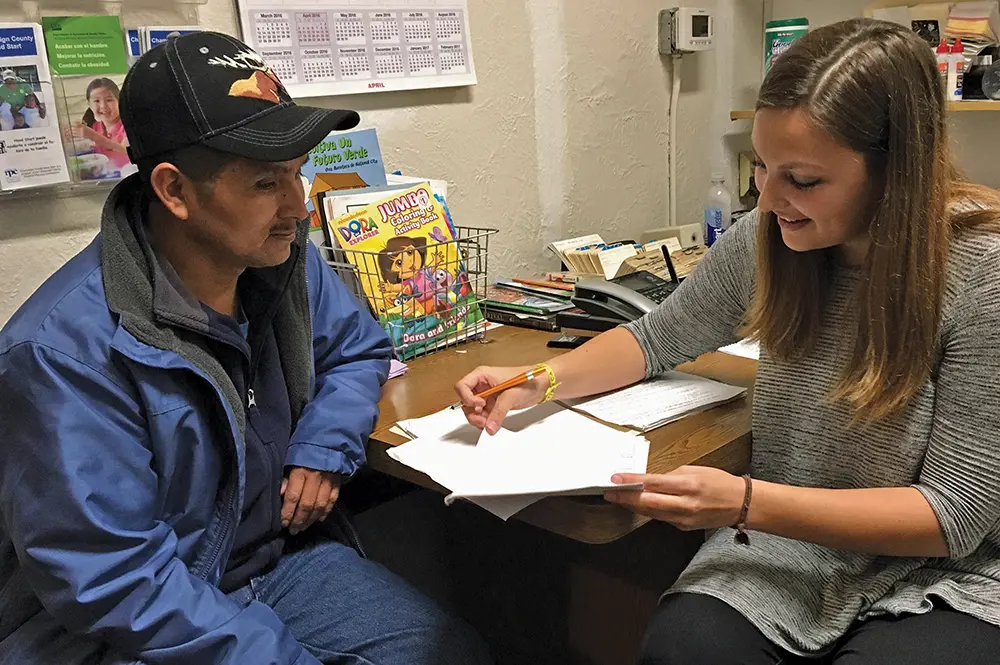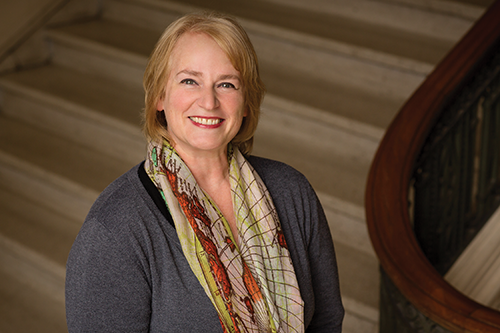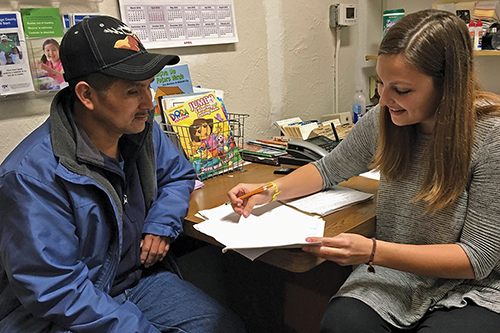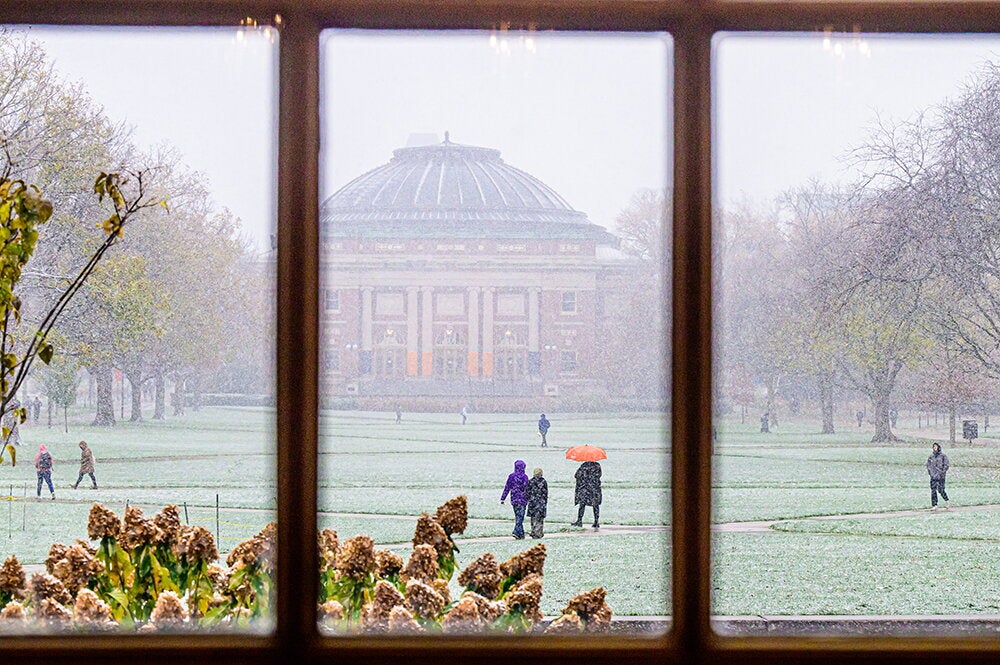

“I used to think immigrants were a problem.”
When Ann Abbott read this introduction to a student’s final essay, she realized the Spanish in the Community curriculum may be one of the most unique and important experiences of which she’s been a part.
“Those words, ‘I used to’—that’s really impactful,” said Abbott, director of undergraduate studies and associate professor in the Department of Spanish & Portuguese. In fact, she sees those words as the culmination of years of effort to deepen her students’ learning while serving a community need.
Several blocks from the University of Illinois campus is The Refugee Center. In 2004, the center was facing the beginnings of a large wave of Spanish-speaking immigrants moving into Champaign and Urbana. A friend and volunteer at the center told Abbott that they needed people who could communicate with the newcomers.
“At the same time, I knew I had these really great Spanish students in the Foreign Languages Building. We sit in these rooms with each other, we talk to each other, and they could really use a boost to get even better,” Abbott said. With this information, Abbott created a Spanish course based in the idea of community service. The class opened in 2004 with grant support for courses rooted in public engagement.

Word of the new class spread throughout the community as well as between students. More avenues of service were discovered and sections of the class were added as the course was formalized and recently became the first non-English general education course on campus. Since it began, hundreds of Illinois students have served at the refugee center, area schools, and the New American Welcome Center, a program at the University YMCA to help immigrants integrate into Champaign County, by providing language assistance to immigrants.
Because of her drive to continue to meet this need, Abbott has been named a recipient of the 2019 City of Champaign Community Impact Award at a time when the 15-year-old course may be as popular as ever. Last semester, nearly 60 students enrolled in three sections. She said the popularity of the class has allowed for a unique mixture of students to enroll.
For example, last semester the class makeup included around 50 percent heritage language learners (students who have Spanish as a first language), which is a contrast to a traditional classroom that includes more second language learners.
“I think having this mixture of heritage language learners and second language learners in the course together enriches the conversation, because their perspective is so valuable,” she said.
The class, which helps fulfill the university’s U.S. minority cultures course requirement, stipulates that students to spend two hours each week in the community in addition to two hours in the classroom. In the final weeks of the course, students participate in an interactive digital simulation–provided through a collaboration with the Siebel Center for Design–that places students in scenarios involving poverty and immigration. It’s the combination of these experiences that sets apart the class from other classroom structures.
“It’s a balancing act,” she said. “For a lot of my students it fills them up with this kind of energy. It’s a nice break from other kinds of learning they are doing.”
Kathleen Flores, a sophomore studying psychology and Spanish, took the class as a freshman and, after completing the course, has continued to volunteer at the center where she helps community members translate medical and benefit forms among other tasks.
“Some days it’s slow, and some days there are lines and lines,” Flores said. “Translating documents, playing with the kids to keep them distracted and comfortable while someone else helps their parents. The experience and the connection I got out ofthis is so valuable to me that I’m doing much more this semester.”
Ultimately, the students are completing valuable and manageable tasks. This process allows the students to build their confidence by shifting the focus from their language skills to helping others.
“Having good Spanish doesn’t mean no mistakes; it means, in context, using it to bridge those language and cultural divides,” Abbott said. Students are required to serve 28 hours per semester. Recently, Abbott has begun allowing some of that time to be used attending campus lectures that give students an opportunity to hear academic-minded individuals speak about immigration in different contexts.
“One of the challenges in this course—and one of the wonderful things—is that students get really attached to a kid or supervisor or a client when they are able to help them,” Abbott explained. “What’s good about that is they can see the big immigration issue through the prism of one person who they have come to know. That changes what they think about immigration.”
However, Abbott explained that there must also be a way to learn about widespread, public policies. If the students think only about the individuals that they help at the refugee center or elsewhere, they could lose the bigger picture, she said.
“It is also about the bigger picture, policy issues, political discourse, the media images that are replayed over and over,” Abbott said. “My challenge is always helping them to find the forest and the trees. If you see one and not the other, it warps the picture that you have.”
It’s also this divide that keeps Abbott determined to help students experience Spanish as a language of the United States.
“You can talk about it, but when you experience (Spanish in the United States) you understand what you’ve been working for, why you have been studying for all these years, what you can do with your Spanish, and, even in Central Illinois, how valuable it is,” she said.
As she accepted the Community Impact Award, Abbott said she was honored to have fellow community members recognize her dedication to both the center and students through transitions in personnel and the makeup of today’s immigrant community members.
“If I look at it now, we have a very different kind of wave but still very important wave of immigration from Spanish-speaking countries,” Abbott explained. “Many are from Central America, many of them are children, sometimes by themselves. For some of them, Spanish is not their first language.”
This has led Abbott to shift classroom discussions toward Central America, unaccompanied minors, violence in Central America and the roots of that violence, and public policy.
“My students come into class loving Spanish, but that doesn’t mean they still haven’t absorbed the myths and negative, dominant discourse about immigration in America,” Abbott explained. “So, I think this is an important opportunity for us to tell them the truth about immigration in the United States, and it’s important to see this for themselves.”
Editor's note: This story originally appeared in the Spring 2020 issue of LAS News magazine.


